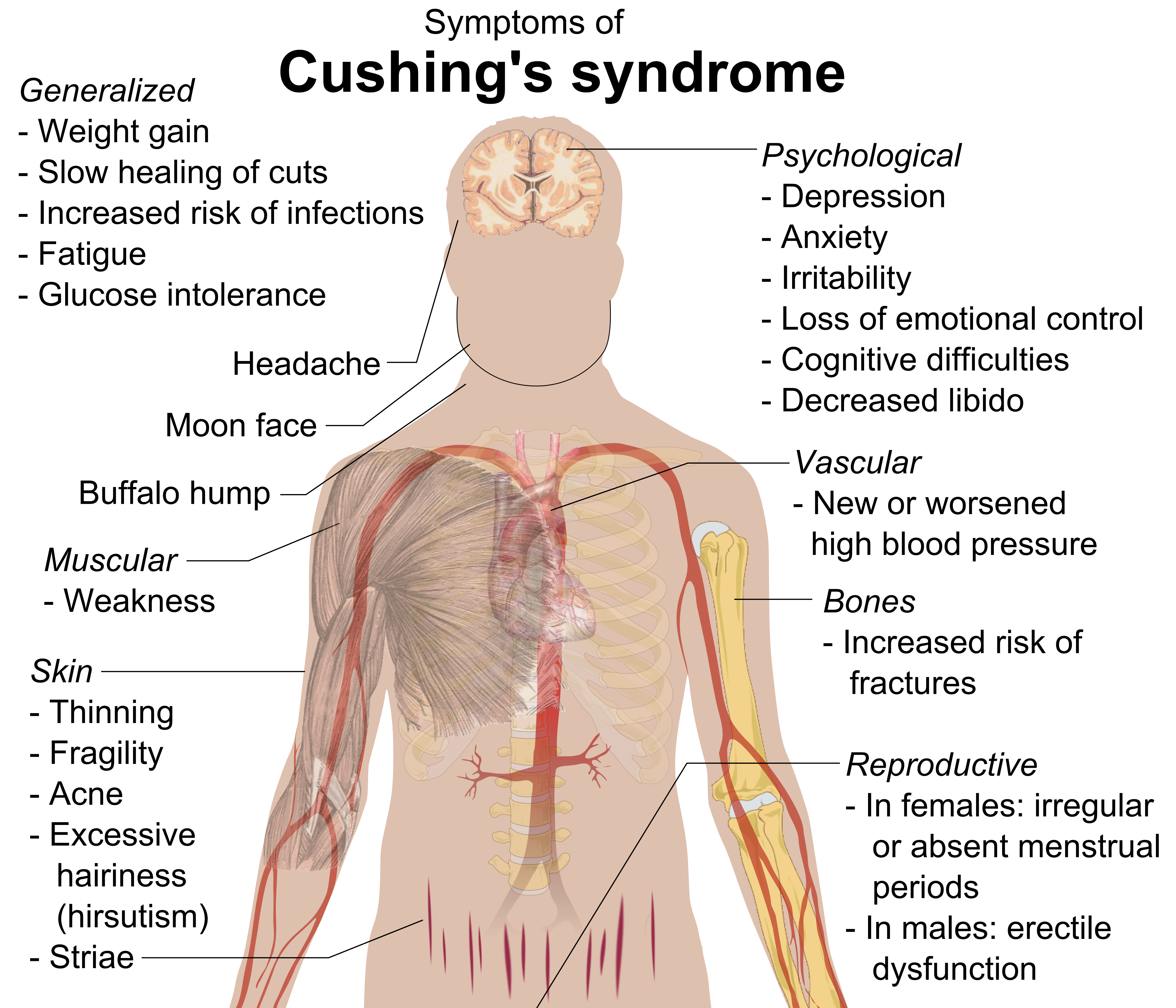|
Hirsutism
Hirsutism is excessive body hair on parts of the body where hair is normally absent or minimal. The word is from early 17th century: from Latin ''hirsutus'' meaning "hairy". It usually refers to a "male" pattern of hair growth in a female that may be a sign of a more serious medical condition, especially if it develops well after puberty. Cultural stigma against hirsutism can cause much psychological distress and social difficulty. Discrimination based on facial hirsutism often leads to the avoidance of social situations and to symptoms of anxiety and depression. Hirsutism is usually the result of an underlying endocrine imbalance, which may be adrenal, ovarian, or central. It can be caused by increased levels of androgen hormones. The amount and location of the hair is measured by a Ferriman-Gallwey score. It is different from hypertrichosis, which is excessive hair growth anywhere on the body. Treatments may include certain birth control pills, antiandrogens, or insulin ... [...More Info...] [...Related Items...] OR: [Wikipedia] [Google] [Baidu] |
Hypertrichosis
Hypertrichosis is an abnormal amount of hair growth over the body. The two distinct types of hypertrichosis are generalized hypertrichosis, which occurs over the entire body, and localized hypertrichosis, which is restricted to a certain area. Hypertrichosis can be either congenital (present at birth) or acquired later in life. The excess growth of hair occurs in areas of the skin with the exception of androgen-dependent hair of the pubic area, face, and axillary regions. Several circus sideshow performers in the 19th and early 20th centuries, such as Julia Pastrana, had hypertrichosis. Many of them worked as freaks and were promoted as having distinct human and animal traits. Classification Two methods of classification are used for hypertrichosis. One divides them into either generalized versus localized hypertrichosis, while the other divides them into congenital versus acquired. Congenital Congenital forms of hypertrichosis are caused by genetic mutations, and are ex ... [...More Info...] [...Related Items...] OR: [Wikipedia] [Google] [Baidu] |
Antiandrogens
Antiandrogens, also known as androgen antagonists or testosterone blockers, are a class of drugs that prevent androgens like testosterone and dihydrotestosterone (DHT) from mediating their biological effects in the body. They act by blocking the androgen receptor (AR) and/or inhibiting or suppressing androgen production. They can be thought of as the functional opposites of AR agonists, for instance androgens and anabolic steroids (AAS) like testosterone, DHT, and nandrolone and selective androgen receptor modulators (SARMs) like enobosarm. Antiandrogens are one of three types of sex hormone antagonists, the others being antiestrogens and antiprogestogens. Antiandrogens are used to treat an assortment of androgen-dependent conditions. In men, antiandrogens are used in the treatment of prostate cancer, enlarged prostate, scalp hair loss, overly high sex drive, unusual and problematic sexual urges, and early puberty. In women, antiandrogens are used to treat acne, seborrhea, ... [...More Info...] [...Related Items...] OR: [Wikipedia] [Google] [Baidu] |
Polycystic Ovary Syndrome
Polycystic ovary syndrome, or PCOS, is the most common endocrine disorder in women of reproductive age. The syndrome is named after the characteristic cysts which may form on the ovaries, though it is important to note that this is a sign and not the underlying cause of the disorder. Women with PCOS may experience irregular menstrual periods, heavy periods, excess hair, acne, pelvic pain, difficulty getting pregnant, and patches of thick, darker, velvety skin. The primary characteristics of this syndrome include: hyperandrogenism, anovulation, insulin resistance, and neuroendocrine disruption. A review of the international evidence found that the prevalence of PCOS could be as high as 26% among some populations, though ranges between 4% and 18% are reported for general populations. Despite its high prevalence, the exact cause of PCOS remains uncertain and there is no known cure. Definition Two definitions are commonly used: * NIH : In 1990 a consensus workshop sponsore ... [...More Info...] [...Related Items...] OR: [Wikipedia] [Google] [Baidu] |
Birth Control Pill
The combined oral contraceptive pill (COCP), often referred to as the birth control pill or colloquially as "the pill", is a type of birth control that is designed to be taken orally by women. The pill contains two important hormones: progestin (a synthetic form of the hormone progestogen/progesterone) and estrogen (usually ethinylestradiol and 17β estradiol). When taken correctly, it alters the menstrual cycle to eliminate ovulation and prevent pregnancy. COCPs were first approved for contraceptive use in the United States in 1960, and are a very popular form of birth control. They are used by more than 100 million women worldwide and by about 9 million women in the United States. From 2015 to 2017, 12.6% of women aged 15–49 in the US reported using COCPs, making it the second most common method of contraception in this age range (female sterilization is the most common method). Use of COCPs, however, varies widely by country, age, education, and marital status. For exam ... [...More Info...] [...Related Items...] OR: [Wikipedia] [Google] [Baidu] |
Cushing's Syndrome
Cushing's syndrome is a collection of signs and symptoms due to prolonged exposure to glucocorticoids such as cortisol. Signs and symptoms may include high blood pressure, abdominal obesity but with thin arms and legs, reddish stretch marks, a round red face, a fat lump between the shoulders, weak muscles, weak bones, acne, and fragile skin that heals poorly. Women may have more hair and irregular menstruation. Occasionally there may be changes in mood, headaches, and a chronic feeling of tiredness. Cushing's syndrome is caused by either excessive cortisol-like medication, such as prednisone, or a tumor that either produces or results in the production of excessive cortisol by the adrenal glands. Cases due to a pituitary adenoma are known as Cushing's disease, which is the second most common cause of Cushing's syndrome after medication. A number of other tumors, often referred to as ectopic due to their placement outside the pituitary, may also cause Cushing's. Some of ... [...More Info...] [...Related Items...] OR: [Wikipedia] [Google] [Baidu] |
Adrenocortical Adenoma
Adrenocortical adenoma is commonly described as a benign neoplasm emerging from the cells that comprise the adrenal cortex. Like most adenomas, the adrenocortical adenoma is considered a benign tumor since the majority of them are non-functioning and asymptomatic. Adrenocortical adenomas are classified as ACTH-independent disorders, and are commonly associated with conditions linked to hyperadrenalism such as Cushing's syndrome (hypercortisolism) or Conn's syndrome ( hyperaldosteronism), which is also known as primary aldosteronism. In addition, recent case reports further support the affiliation of adrenocortical adenomas with hyperandrogenism or florid hyperandrogenism which can cause hyperandrogenic hirsutism in females. "Cushing's syndrome" differs from the "Cushing's disease" even though both conditions are induced by hypercortisolism. The term "Cushing's disease" refers specifically to "secondary hypercortisolism" classified as "ACTH-dependent Cushing's syndrome" caused by ... [...More Info...] [...Related Items...] OR: [Wikipedia] [Google] [Baidu] |
Congenital Adrenal Hyperplasia
Congenital adrenal hyperplasia (CAH) is a group of autosomal recessive disorders characterized by impaired cortisol synthesis. It results from the deficiency of one of the five enzymes required for the synthesis of cortisol in the adrenal cortex. Most of these disorders involve excessive or deficient production of hormones such as glucocorticoids, mineralocorticoids, or sex steroids, and can alter development of primary or secondary sex characteristics in some affected infants, children, or adults. It is one of the most common autosomal recessive disorders in humans. Types CAH can occur in various forms. The clinical presentation of each form is different and depends to a large extent on the underlying enzyme defect, its precursor retention, and deficient products. Classical forms appear in infancy, and nonclassical forms appear in late childhood. The presentation in patients with classic CAH can be further subdivided into two forms: salt-wasting and simple-virilizing, depending ... [...More Info...] [...Related Items...] OR: [Wikipedia] [Google] [Baidu] |
Body Hair
Body hair, or androgenic hair, is the terminal hair that develops on the human body during and after puberty. It is differentiated from the head hair and less visible vellus hair, which is much finer and lighter in color. The growth of androgenic hair is related to the level of androgens (often referred to as male hormones) and the density of androgen receptors in the dermal papillae. Both must reach a threshold for the proliferation of hair follicle cells. From childhood onward, regardless of sex, vellus hair covers almost the entire area of the human body. Exceptions include the lips, the backs of the ears, palms of hands, soles of the feet, certain external genital areas, the navel, and scar tissue. The density of hair – i.e. the number of hair follicles per unit area of skin – varies from person to person. In many cases, areas on the human body that contain vellus hair will begin to produce darker and thicker body hair during puberty, such as the first growth ... [...More Info...] [...Related Items...] OR: [Wikipedia] [Google] [Baidu] |
Acromegaly
Acromegaly is a disorder that results from excess growth hormone (GH) after the growth plates have closed. The initial symptom is typically enlargement of the hands and feet. There may also be an enlargement of the forehead, jaw, and nose. Other symptoms may include joint pain, thicker skin, deepening of the voice, headaches, and problems with vision. Complications of the disease may include type 2 diabetes, sleep apnea, and high blood pressure. Acromegaly is usually caused by the pituitary gland producing excess growth hormone. In more than 95% of cases the excess production is due to a benign tumor, known as a pituitary adenoma. The condition is not inherited from a person's parents. Acromegaly is rarely due to a tumor in another part of the body. Diagnosis is by measuring growth hormone after a person has consumed a glucose solution, or by measuring insulin-like growth factor I in the blood. After diagnosis, medical imaging of the pituitary is carried out to determine if an ... [...More Info...] [...Related Items...] OR: [Wikipedia] [Google] [Baidu] |
Congenital Adrenal Hyperplasia Due To 21-hydroxylase Deficiency
Congenital adrenal hyperplasia due to 21-hydroxylase deficiency, in all its forms, accounts for over 95% of diagnosed cases of congenital adrenal hyperplasia (CAH), and CAH in most contexts refers to 21-hydroxylase deficiency and different mutations related to enzyme impairment have been mapped on protein structure. Presentation Severe, early onset 21-hydroxylase deficient CAH The two most serious neonatal consequences of 21-hydroxylase deficiency occur: life-threatening salt-wasting crises in the first month of life (for male and female infants alike) and severe virilization of female infants. The subdivision of the early onset CAH into salt-wasting and simple-virilizing forms, which is based on the capacity of the adrenal to produce small amounts of aldosterone in the simple-virilizing form, is often not clinically meaningful, because clinical presentations overlap and all patients lose salt to some degree. Salt-wasting crises in infancy The excessive amounts of adrenal tes ... [...More Info...] [...Related Items...] OR: [Wikipedia] [Google] [Baidu] |
Inborn Errors Of Steroid Metabolism
An inborn error of steroid metabolism is an inborn error of metabolism due to defects in steroid metabolism. Types A variety of conditions of abnormal steroidogenesis exist due to genetic mutations in the steroidogenic enzymes involved in the process, of which include: Generalized * 20,22-Desmolase (P450scc) deficiency: blocks production of all steroid hormones from cholesterol * 3β-Hydroxysteroid dehydrogenase 2 deficiency: impairs progestogen and androgen metabolism; prevents the synthesis of estrogens, glucocorticoids, and mineralocorticoids; causes androgen deficiency in males and androgen excess in females * Combined 17α-hydroxylase/17,20-lyase deficiency: impairs progestogen metabolism; prevents androgen, estrogen, and glucocorticoid synthesis; causes mineralocorticoid excess * Cytochrome P450 oxidoreductase deficiency: prevents production of numerous but not all sex steroids, as well as other metabolic reactions Androgen- and estrogen-specific * Isolated 17,20-lyase ... [...More Info...] [...Related Items...] OR: [Wikipedia] [Google] [Baidu] |
Gigantism
Gigantism ( el, γίγας, ''gígas'', "giant", plural γίγαντες, ''gígantes''), also known as giantism, is a condition characterized by excessive growth and height significantly above average. In humans, this condition is caused by over-production of growth hormone in childhood, resulting in people up to in height. It is a rare disorder resulting from increased levels of growth hormone before the fusion of the growth plate which usually occurs at some point soon after puberty. This increase is most often due to abnormal tumor growths on the pituitary gland. Gigantism should not be confused with acromegaly, the adult form of the disorder, characterized by somatic enlargement specifically in the extremities and face. Cause Gigantism is characterized by an excess of growth hormone (GH). The excess of growth hormone that brings about gigantism is virtually always caused by pituitary growths (adenomas). These adenomas are on the anterior pituitary gland. They can also ca ... [...More Info...] [...Related Items...] OR: [Wikipedia] [Google] [Baidu] |






